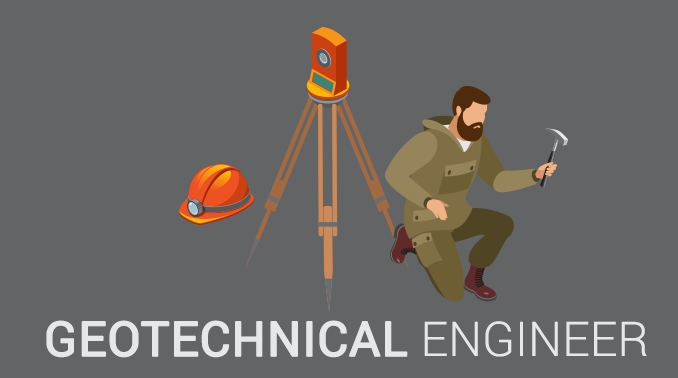Indicators on Geotheta You Should Know
Wiki Article
About Geotheta
Table of ContentsThe Ultimate Guide To GeothetaThe Greatest Guide To GeothetaNot known Details About Geotheta The 4-Minute Rule for GeothetaEverything about Geotheta

They conduct website examinations, collect samples, execute laboratory examinations, and assess data to review the viability of the ground for building jobs - Tailings Engineer. Based upon their findings, geotechnical designers supply recommendations for structure style, slope stability, maintaining frameworks, and reduction of geotechnical dangers. They work together with various other specialists, such as engineers, structural engineers, and construction groups, to guarantee that geotechnical considerations are incorporated right into the total project layout and execution
By evaluating the actions and buildings of dirt and rock, they can determine potential geotechnical risks such as landslides, dirt settlement, or incline instability. Their experience aids prevent failures or mishaps that could endanger lives and property. Here are some thorough obligations and responsibilities of a geotechnical engineer: Website Investigation: Geotechnical designers conduct site examinations to collect information on subsurface conditions.
They analyze the data to recognize the homes and behavior of the dirt and rock, including their strength, permeability, compaction features, and groundwater problems. Geotechnical Analysis and Layout: Geotechnical engineers assess the data gathered throughout site examinations to examine the security and viability of the site for building and construction jobs. They execute geotechnical estimations and modeling to examine aspects such as bearing capacity, settlement, incline security, lateral earth stress, and groundwater circulation.
Rumored Buzz on Geotheta
Structure Design: Geotechnical designers play an important duty in making structures that can safely sustain the designated framework. They analyze the soil conditions and lots needs to figure out the suitable foundation type, such as superficial structures (e.g., grounds), deep structures (e.g (https://geotheta.webflow.io/)., heaps), or specialized techniques like soil enhancement. They think about factors such as negotiation restrictions, birthing capability, and soil-structure interaction to establish optimum structure designsThey assess construction plans, screen site tasks, and carry out field assessments to validate that the design referrals are complied with. If unpredicted geotechnical problems occur, they assess the scenario and provide suggestions for removal or modifications to the design. Threat Evaluation and Reduction: Geotechnical designers assess geotechnical risks and threats connected with the task website, such as landslides, liquefaction, or soil disintegration.

Partnership and Interaction: Geotechnical engineers work very closely with other experts associated with a project, such as engineers, architectural engineers, and building and construction groups. Reliable communication and cooperation are necessary to incorporate geotechnical considerations into the total job design and construction procedure. Geotechnical engineers give technical proficiency, solution questions, and ensure that geotechnical needs are satisfied.
Some Ideas on Geotheta You Should Know
Right here are some sorts of geotechnical engineers: Foundation Engineer: Structure designers specialize in developing and analyzing foundations for structures. They analyze the soil conditions, load demands, and site features to figure out one of the most ideal structure kind and design, such as shallow foundations, deep structures, or specialized strategies like pile structures.They review the variables influencing slope security, such as dirt properties, groundwater conditions, and slope geometry, and establish approaches to stop incline failures and mitigate dangers. Quake Designer: Quake designers focus on analyzing and developing structures to withstand seismic forces. They examine the seismic hazard of a site, examine dirt liquefaction potential, and establish seismic style requirements to ensure the safety and security and resilience of structures throughout quakes.
They execute field screening, gather examples, and examine the collected data to characterize the dirt buildings, geologic formations, and groundwater conditions at a site. Geotechnical Instrumentation Engineer: Geotechnical instrumentation designers concentrate on surveillance and measuring the behavior of soil, rock, and structures. They mount and preserve instrumentation systems that keep an eye on elements such as dirt settlement, groundwater degrees, incline motions, and structural variations to evaluate efficiency and give early cautions of possible concerns.
The 5-Second Trick For Geotheta
They perform examinations such as triaxial examinations, loan consolidation tests, straight shear tests, and permeability examinations to gather data for geotechnical analysis and design. Geosynthetics Designer: Geosynthetics designers concentrate on the layout and application of geosynthetic materials, such as geotextiles, geogrids, and geomembranes. They use these products to improve soil security, enhance slopes, supply water drainage solutions, and control erosion.They often tend to be investigatory individuals, which implies they're intellectual, reflective, and inquisitive. They are interested, methodical, rational, analytical, and sensible. Several of them are additionally social, indicating they're kind, charitable, participating, client, caring, helpful, understanding, skillful, and friendly. Does this seem like you? Take our totally free job examination to locate out if geotechnical designer is one of your top job matches.
In the office setting, geotechnical designers make use of specialized software program tools to do calculations, develop layouts, and analyze data. They prepare records, review project specs, interact with customers and staff member, and coordinate job activities. The office setting supplies Continued a helpful environment for research, evaluation, and partnership with various other professionals associated with the job.
Fascination About Geotheta
They frequently see project websites to perform site examinations, analyze geotechnical problems, and gather data for analysis. These gos to entail traveling to different locations, often in remote or challenging terrains. Geotechnical engineers might execute soil sampling, conduct examinations, and display building tasks to make certain that the geotechnical aspects of the job are being carried out appropriately.Geotechnical engineers likewise operate in specialized geotechnical labs. In these centers, they conduct experiments, execute tests on soil and rock examples, and evaluate the engineering residential properties of the materials. Geotechnical research laboratory designers work thoroughly in these atmospheres, managing screening devices, operating tools, and tape-recording information. They work together with other laboratory team to guarantee accurate and trusted testing outcomes.
Report this wiki page